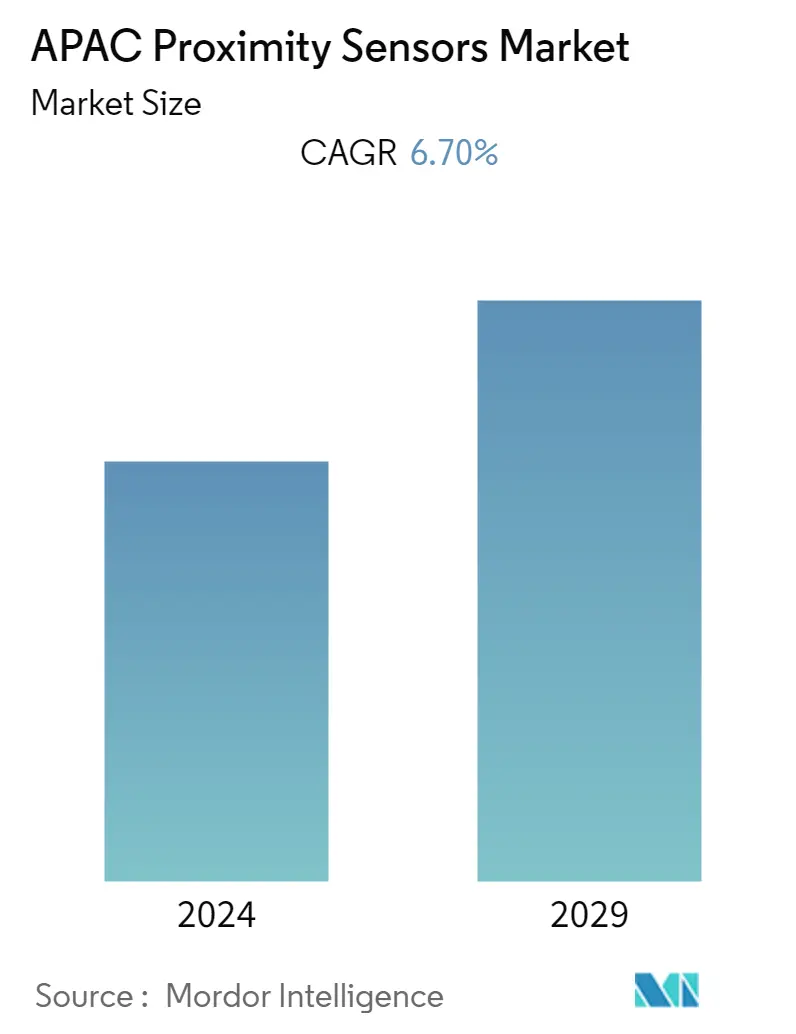Market Size of APAC Proximity Sensors Industry

| Study Period | 2019 - 2029 |
| Base Year For Estimation | 2023 |
| Forecast Data Period | 2024 - 2029 |
| Historical Data Period | 2019 - 2022 |
| CAGR | 6.70 % |
| Market Concentration | High |
Major Players
*Disclaimer: Major Players sorted in no particular order |
APAC Proximity Sensors Market Analysis
The Asia Pacific proximity sensor market is expected to grow at a CAGR of 6.70% during the forecast period. Technological advancements in countries like Japan, China, and India have increased domestic production of smartphones. This, in turn, made them cheaper. Technologies, such as GPS, cameras, and displays, which use proximity sensors for motion detection and location-sensing in smartphones, have also become cheaper. These factors are projected to propel the growth of the global automotive proximity sensor market during the forecast period.
- Rapid industrialization and economic developments in the Asia-Pacific region are attracting investors in countries, such as China and India. Moreover, an increase in smartphone production, vehicle production, and sales are fueling the market for automotive proximity sensors in the region.
- The significant presence in the semiconductor industry and South Korea's efforts to increase semiconductor, electronics, and components manufacturing are estimated to contribute to the market share of the proximity sensors in the country. According to Korea International Trade Association, South Korea imported semiconductor manufacturing equipment worth a total of USD 1.212 billion from Japan in the first five months of 2019.
- The region has been witnessing numerous developments in the proximity sensors for the deployment in the consumer electronics. For instance, Elliptic Labs' AI Virtual Proximity Sensor TM, INNER BEAUTY, has been deployed in Xiaomi Redmi K30 smartphone models, the first phones Redmi series to feature Elliptic Labs' technology. The sensor enables OEMs to deliver phones with a simple, full-screen design.
- Furthermore, various government programs, such as the Made in China 2025 plan, are promoting the use of R&D in factory automation and technologies and their investments. Also, as most of the automation equipment is imported from Germany and Japan, the 'Made in China' initiative aims to expand the country's domestic production of automation hardware and equipment.
- The industry's shift toward the production of connected and ASAS-assisted vehicles in South Korea is driving the growth. In 2018, the South Korean government mandated AEB from January 2019 in all new passenger vehicles. These mandates will drive the growth of the ADAS market in the near future, which would further boost the market for proximity sensors.
APAC Proximity Sensors Industry Segmentation
A proximity sensor is a sensor that is able to detect the presence of nearby objects without any physical contact. For sensing objects, this sensor radiates or emits a beam of electromagnetic radiation, usually in the form of infrared light, and detects the reflection to determine the object's proximity or distance from the sensor. A proximity sensor often emits an electromagnetic field or a beam of electromagnetic radiation (for instance, infrared) and detects changes in the field or return signal.
| Technology | |
| Inductive | |
| Capacitive | |
| Photoelectric | |
| Magnetic |
| End-User | |
| Aerospace and Defense | |
| Automotive | |
| Industrial | |
| Consumer Electronics | |
| Food and Beverage | |
| Other End-user Verticals |
| Country | |
| China | |
| South Korea | |
| Japan | |
| India | |
| Rest of Asia Pacific |
APAC Proximity Sensors Market Size Summary
The Asia Pacific proximity sensor market is poised for significant growth, driven by technological advancements and increased production in key sectors such as electronics and automotive. Countries like Japan, China, and India are at the forefront, with advancements in smartphone technology making proximity sensors more affordable and widely used. The region's rapid industrialization and economic development are attracting substantial investments, particularly in China and India, further fueling the demand for proximity sensors. South Korea's strong presence in the semiconductor industry and its efforts to boost electronics manufacturing are also contributing to the market's expansion. Government initiatives, such as China's Made in China 2025 plan, are promoting research and development in factory automation, which is expected to enhance the market's growth trajectory.
The Asia Pacific region is a global hub for electronics production, with a high demand for smartphones and wearables driving the need for proximity sensors. The increasing adoption of industrial robots, particularly in China, is also a significant factor, as these robots require proximity sensors for efficient operation. Major players like Omron Corporation, Keyence Corporation, and TDK Corporation dominate the market, focusing on expanding their global presence and leveraging strategic collaborations. Despite the market's concentration, mid-size and smaller companies are gaining traction through technological innovations and new market entries. The region's robust production capabilities and growing consumer base for smart devices are expected to sustain the market's growth over the forecast period.
APAC Proximity Sensors Market Size - Table of Contents
-
1. MARKET DYNAMICS
-
1.1 Market Overview
-
1.2 Industry Value Chain Analysis
-
1.3 Industry Attractiveness - Porter's Five Forces Analysis
-
1.3.1 Bargaining Power of Suppliers
-
1.3.2 Bargaining Power of Buyers
-
1.3.3 Threat of New Entrants
-
1.3.4 Intensity of Competitive Rivalry
-
1.3.5 Threat of Substitute Products
-
-
1.4 Impact of COVID-19 on the Market
-
1.5 Market Drivers
-
1.5.1 Growth in Industrial Automation
-
-
1.6 Market Restraints
-
1.6.1 Limitations in Sensing Capabilities
-
-
-
2. MARKET SEGMENTATION
-
2.1 Technology
-
2.1.1 Inductive
-
2.1.2 Capacitive
-
2.1.3 Photoelectric
-
2.1.4 Magnetic
-
-
2.2 End-User
-
2.2.1 Aerospace and Defense
-
2.2.2 Automotive
-
2.2.3 Industrial
-
2.2.4 Consumer Electronics
-
2.2.5 Food and Beverage
-
2.2.6 Other End-user Verticals
-
-
2.3 Country
-
2.3.1 China
-
2.3.2 South Korea
-
2.3.3 Japan
-
2.3.4 India
-
2.3.5 Rest of Asia Pacific
-
-
APAC Proximity Sensors Market Size FAQs
What is the current APAC Proximity Sensors Market size?
The APAC Proximity Sensors Market is projected to register a CAGR of 6.70% during the forecast period (2024-2029)
Who are the key players in APAC Proximity Sensors Market?
Panasonic Corporation , Delta Electronics Inc. , Keyence Corporation , TDK Corporation and Autonics Corporation are the major companies operating in the APAC Proximity Sensors Market.

